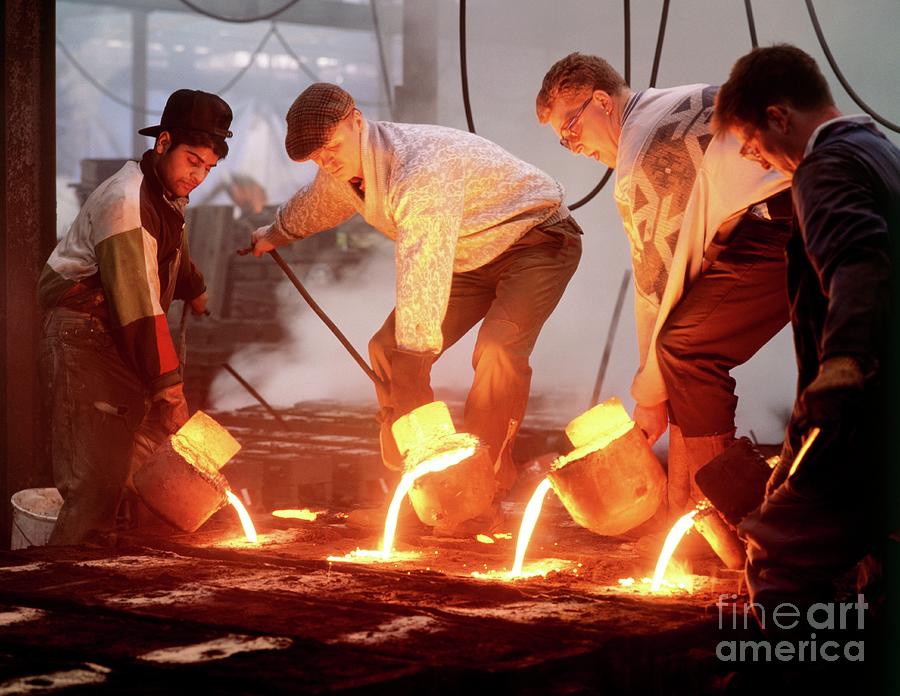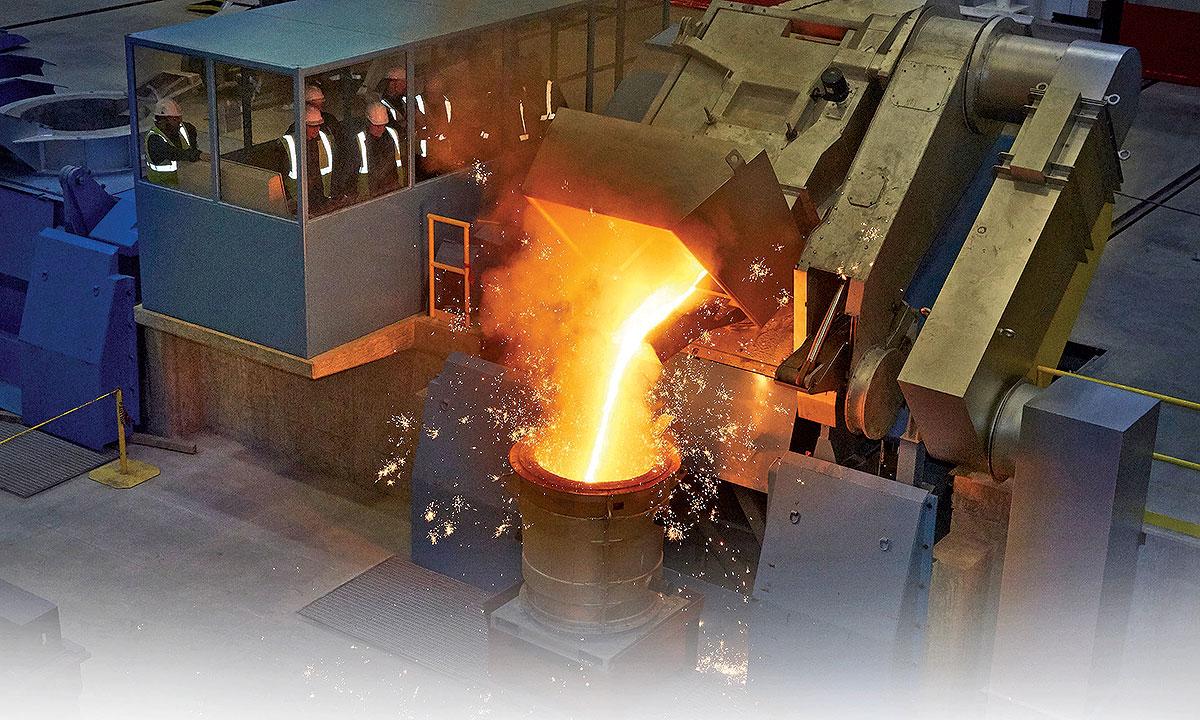Discover the Cutting-edge Strategies Utilized in a Metal Foundry for Superior Casting Results
In today's affordable manufacturing landscape, metal foundries are significantly embracing ingenious techniques to boost spreading outcomes - Metal Casting. Advanced computer simulations permit for accurate modeling of liquified metal habits, while 3D printing makes it possible for fast manufacturing of complex molds. Furthermore, environmentally friendly materials and automation improve operations. These developments assure significant improvements in performance and quality assurance. The impact of these innovations on sustainability and manufacturing methods continues to be to be fully explored.
Advanced Computer Simulations in Metal Casting
Advanced computer simulations have actually changed the metal spreading procedure by enhancing precision and performance. These advanced tools permit designers to create virtual models of actors parts, allowing them to analyze and predict the behavior of molten metal throughout the spreading phase. By imitating numerous specifications such as temperature level, flow rate, and air conditioning rates, makers can determine prospective flaws prior to physical production starts.
This positive approach reduces waste and lessens expensive errors, ultimately causing boosted item top quality. In addition, simulations facilitate the optimization of mold and mildew layouts, making certain that they meet the certain requirements of each project. The combination of computational liquid characteristics (CFD) and limited component analysis (FEA) more adds to the precision of these simulations, providing insights that were previously unattainable. Because of this, progressed computer system simulations have come to be a vital element of modern-day metal foundries, greatly progressing the industry's capabilities.
3D Printing for Mold And Mildews and Patterns
3D printing has become a groundbreaking method for producing mold and mildews and patterns in the metal foundry industry. This technology makes it possible for the rapid manufacturing of complex geometries that standard production approaches battle to attain. By utilizing additive production, foundries can create elaborate layouts with lowered preparations and product waste. The capacity to produce mold and mildews on need enables for better adaptability in layout iterations, assisting in faster prototyping and alterations.
Furthermore, 3D printing can make use of a variety of materials, consisting of plastics and metals, tailored to details casting needs. This flexibility enhances the accuracy of mold and mildews, resulting in premium casting outcomes with improved surface area coatings. Furthermore, the reduction in the variety of components required streamlines setting up processes, further maximizing manufacturing effectiveness. As foundries remain to adopt 3D printing, they are poised to redefine industry criteria, leading the method for innovation and enhanced efficiency in metal spreading operations.
Eco-Friendly Products and Processes
As the metal foundry sector deals with boosting stress to minimize its environmental impact, the fostering of eco-friendly materials and procedures has come to be necessary. Shops are currently checking out sustainable alternatives to standard materials, such as using recycled metals and bio-based binders. These products not only lessen waste yet also reduced energy usage during production.
Additionally, developments in sand casting strategies have brought about the use of artificial sands that are less dangerous to the environment. Foundries are also executing cutting-edge processes like molten metal therapy that minimizes emissions and enhances the top quality of actors products.
Moreover, water-based coverings have actually changed harmful solvents, promoting a more secure workplace (Aluminum Foundry). By incorporating these eco-friendly practices, metal foundries can markedly decrease their environmental impact while keeping top notch spreading results. This change not just profits the atmosphere but also straightens with the expanding consumer need for sustainable production solutions
Automation and Robotics in Foundry Workflow
While the metal foundry market accepts development, the combination of automation and robotics is changing procedures greatly. Automated systems improve processes such as mold and mildew making, metal pouring, and casting completing, considerably enhancing effectiveness. view publisher site Robotics help with the handling of hefty materials, lowering the danger of workplace injuries and making certain safer environments.

Better, making use of automated led cars (AGVs) maximizes product transport within facilities, making sure prompt delivery of components to appropriate workstations. By applying these technologies, foundries can adjust to rising and fall needs read what he said with better agility, inevitably causing improved success and competitiveness out there. As automation and robotics remain to progress, they hold the possible to redefine conventional foundry methods and drive more developments in casting techniques.
Real-Time Surveillance and Quality Assurance Techniques
The improvements in automation and robotics have actually led the way for much more sophisticated strategies to quality control in metal foundries. Real-time surveillance systems make use of advanced sensors and data analytics to track essential parameters throughout the casting procedure. These systems constantly assess variables such as temperature, material, and pressure structure, making it possible for instant discovery of discrepancies from established standards.
Quality assurance techniques currently incorporate machine learning algorithms that examine historical data to predict prospective flaws prior to they take place. This positive method lessens waste and enhances total production effectiveness. In addition, integrated responses loopholes allow for fast changes, making sure that each casting meets rigorous high quality demands.
The implementation of electronic twins-- virtual reproductions of physical possessions-- has additionally transformed high quality guarantee, allowing engineers to imitate and maximize processes in real-time. With each other, these ingenious techniques considerably enhance the integrity and quality of spreadings, setting brand-new industry standards in metal foundry operations.
Often Asked Questions
What Types of Metals Are Typically Cast in Foundries?
Frequently cast metals in foundries include Get More Information aluminum, bronze, iron, and brass. Each metal displays unique residential or commercial properties, making them suitable for numerous applications, such as automobile parts, machinery, and imaginative sculptures, enhancing their versatility in manufacturing.

The length of time Does the Casting Process Commonly Take?
The casting process commonly takes several hours to days, depending upon factors such as the intricacy of the mold, sort of metal made use of, and air conditioning requirements. Each stage influences the general duration markedly.
What Safety Actions Remain In Area for Foundry Workers?

Just how Are Problems in Castings Identified and Addressed?
Defects in spreadings are recognized via visual examinations and non-destructive screening approaches. When found, foundry employees resolve them by improving procedures, adjusting material make-ups, and applying restorative measures to guarantee top quality and conformity with standards.
What Is the Cost Range for Metal Casting Providers?
The price array for metal spreading services typically ranges $1 to $10 per extra pound, depending upon factors such as product kind, intricacy of the style, and manufacturing quantity, impacting general rates substantially.
In today's affordable manufacturing landscape, metal foundries are progressively adopting cutting-edge methods to enhance casting results. As the metal foundry market encounters raising stress to minimize its ecological footprint, the adoption of green products and processes has actually ended up being essential. Foundries are currently discovering sustainable alternatives to typical products, such as making use of recycled metals and bio-based binders. By integrating these environment-friendly practices, metal foundries can substantially decrease their environmental effect while keeping top quality spreading results. The improvements in automation and robotics have actually paved the way for extra innovative approaches to top quality guarantee in metal foundries.